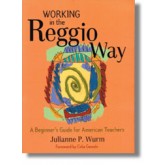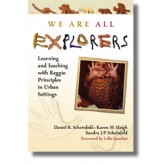THIS SECTION IS CURRENTLY IN PROGRESS–CHECK BACK SOON FOR LINKS AND MORE!
STANDARDS SECTION:
REGGIO 101 (scroll down for STANDARDS sections)
What does “Reggio Inspired” mean, anyway?
From Wikipedia: The Reggio Emilia Approach is an educational philosophy focused on preschool and primary education. It was started by Loris Malaguzzi and the parents of the villages around Reggio Emilia, Italy after World War II. They felt that it is in the early years of development that children form who they are as individuals. This led to the creation of a program based on the principles of respect, responsibility, and community through exploration and discovery. This is substantiated by a supportive and enriching environment based on the interests of the children through a self-guided curriculum.
The most important aspect is putting the child first, and facilitating their learning and exploration. This is why a small class size is so important—to give each child the time and attention he or she deserves.
We believe…
* Children are capable, aware, responsible, and that they have the ability to create their own knowledge
* Children deserve an environment and schedule that puts their needs first
* Children must have access to organic, nutrient-rich foods for optimal brain development
* Children must be able to play without being exposed to dangerous chemicals and toxins in toys or their environment (this includes noise pollution)
* Children must be allowed to be capable, have a say in their own learning, and be allowed to learn and develop at a holistic pace
* Parents and teachers form a partnership, creating a wholesome environment that feels like home and supports each individual child
One of the most important aspects of a Reggio inspired school is the documentation. As educators, we will be documenting progress your child makes through out the year (photographs, sound clips, drawings, sculptures, anecdotal records, etc.) By the end of the year, you will have a detailed picture of your child’s journey through learning.
If you are interested in learning more about the Reggio Emilia approach:
http://www.reggioemiliaapproach.net/
http://www.brainy-child.com/article/reggioemilia.shtml
We also recommend the following books to get you started:
****************************************************************
LEARNING STANDARDS
Every school has a group of standards and benchmarks that they seek to meet in the classroom. The manner in which they do so is dependent upon each school’s curriculum map (a plan drafted for the year that guides what teachers need to accomplish in the classroom and how they want to do this) and each teacher’s discretion and experience. These standards are set forth by state and national agencies and apply to all schools (except parochial.)
High-quality teachers seek to meet these standards and benchmarks through facilitating experiences that lead students to make their own discoveries, thereby gaining knowledge through action and hands-on experience (as opposed to a teacher telling the information to a child — cognitively unsophisticated and less powerful learning.) This is considered constructivist learning; the child constructs his or her own meaning through experience. The teacher acts as a facilitator, and when necessary, scaffolds or supports the child to the next level of understanding or mastery.
We wanted to provide our parents with a look at what the MINIMUM required benchmarks are for the preschool and Kindergarten classroom. All of the daily learning and activities that we do are purposeful and seek to meet these benchmarks; we do this through an emergent curriculum that is sculpted each day by the children and teachers together (as opposed to a daily curriculum guide that tells what should be accomplished on each day.) Teachable moments, fluid curriculum, hands-on learning experiences, and listening to / talking with students as much as possible–these precepts are at the heart of Reggio Emilia learning.
The lists you will find below are a framework that you can also use at home — seek to create hands-on experiences for your child built around one or two of these “big ideas”!
Social / Emotional Development
Describe self by using several basic characteristics
Exhibit eagerness and curiosity as a learner
Exhibit persistence and creativity in seeking solutions to problems
Show some initiative and independence in actions
Use appropriate communication skills when expressing needs, wants and feelings
Begin to understand and follow rules
Manage transitions and begin to adapt to change in routines
Show empathy and caring for others
Use the classroom environment purposefully and respectfully
Engage in cooperative group play
Begin to share materials and experiences and take turns
Respect the rights of self and others
Develop relationships with children and adults
Language Arts
Understand that pictures and symbols have meaning and that print carries a message
Understand that reading progresses from left to right and top to bottom
Identify labels and signs in environment
Identify some letters, including those in own name
Make some letter-sound matches
Predict what will happen next using pictures and content for guides
Begin to develop phonological awareness by participating in rhyming activities
Recognize separable and repeating sounds in spoken language
Retell information from a story
Respond to simple questions about reading material
Demonstrate understanding of literal meaning of stories by making comments
Understand that different text forms, such as magazines, notes, lists, letters, and story books are used for different purposes
Show independent interest in reading-related activities
Use scribbles, approximations of letters, or known letters to represent written language
Dictate stories and experiences
Use drawing and writing skills to convey meaning and information
Listen with understanding and respond to directions and conversations
Communicate needs, ideas and thoughts
Seek answers to questions through active exploration
Relate prior knowledge to new information
Communicate information with others
Mathematics
Use concepts that include number recognition, counting and one-to-one correspondence
Count with understanding and recognize “how many” in sets of objects
Solve simple mathematical problems
Explore quantity and number
Connect numbers to quantities they represent using physical models and representations
Make comparisons of quantities
Demonstrate a beginning understanding of measurement using non-standard units and measurement words
Construct a sense of time through participation in daily activities
Show understanding of and use comparative words
Incorporate estimating and measuring activities into play
Sort and classify objects by a variety of properties
Recognize, duplicate and extend simple patterns, such as sequences of sounds, shapes and colors
Begin to order objects in series or rows
Participate in situations that involve addition and subtraction using manipulatives
Describe qualitative change, such as measuring to see who is growing taller
Recognize geometric shapes and structures in the environment
Find and name locations with simple words, such as “near”
Represent data using concrete objects, pictures and graphs
Make predictions about what will happen next
Gather data about themselves and their surroundings
Science
Use senses to explore and observe materials and natural phenomena
Collect, describe and record information
Use scientific tools such as thermometers, balance scales and magnifying glasses for investigation
Become familiar with the uses of devices incorporating technology
Investigate and categorize living things in the environment
Show an awareness of changes that occur in themselves and their environment
Describe and compare basic needs of living things
Make comparisons among objects that have been observed
Describe the effects of forces of nature (wind, gravity, magnetism, etc.)
Use common weather-related vocabulary
Participate in recycling in their environment
Identify basic concepts associated with night/day and seasons
Begin to understand basic safety practices
Express wonder and ask questions about their world
Begin to be aware of technology and how it affects their lives
Social Science
Recognize the reasons for rules
Participate in voting as a way of making choices
Develop an awareness of roles of leaders in their environment
Identify community workers and the services they provide
Begin to understand the use of trade to obtain goods and services
Recall information about the immediate past
Locate objects and places in familiar environments
Express beginning geographic thinking
Recognize similarities and differences in people
Understand that each of us belongs to a family and recognize that families vary
Physical Development and Health
Engage in active play using gross motor skills
Engage in active play using fine motor skills
Coordinate movements to perform complex tasks
Follow simple safety rules while participating in activities
Participate in activities related to physical fitness
Exhibit increased endurance
Follow rules and procedures when participating in group physical activities
Demonstrate ability to cooperate with others during group physical activities
Participate in simple practices that promote healthy living and prevent illness
Identify body parts and their functions
Act independently in caring for personal hygiene needs
Use appropriate communication skills when expressing needs, wants and feelings
Use socially acceptable ways to resolve conflict
Participate in activities to learn to avoid dangerous situations
Foreign Language
Maintain the native language for use in a variety of purposes
Use and maintain the native language in order to build upon and develop transferable language and literacy skills
Fine Arts
Investigate the elements of dance
Investigate the elements of drama
Investigate the elements of music
Investigate the elements of visual arts
Describe or respond to their own creative work or the creative work of others
Participate in dance, drama, music and visual arts activities
Use creative arts as an avenue for self-expression
SONGS: Click title for a printable document
The Animal Sounds Song
Arco Iris_The Rainbow Song
The Letter H Has Many Friends
Continents Song
ARTICLES:
Language Arts and Early Literacy
-What Are Dolch Sight Words?
-Handwriting
-Tripod Grip
–Phonics 101
–Early Literacy Development
Social / Emotional Development
–How to Talk to Little Girls
-Higher Order Thinking
Physical Development and Milestones
-Three Year Olds–Developmental Milestones
–Things to Know About Outdoor Play
Testing and Looking at Schools
–Preparing Your Young Child for Standardized Assessment (gifted testing)
–What to Look for in a Classroom (Alfie Kohn)
VIDEOS:
https://www.youtube.com/watch?v=HmUZgoqrIYA
Mighty Machines
http://youtu.be/E7ULR-yfNnk
https://www.youtube.com/watch?v=E7ULR-yfNnk
Al Jarnow, Celestial Navigations
Signing Time
Linnea in Monet’s Garden
Scholastic Book Series DVD Collection
https://www.youtube.com/watch?v=43_rwdDGGYE
https://www.youtube.com/watch?v=gz_qR8u0VSU
https://www.youtube.com/watch?v=MuXAqFIQTHU
https://www.youtube.com/watch?v=QMAzpwVDON0
WEBSITES:
Arving Gupta Toys


